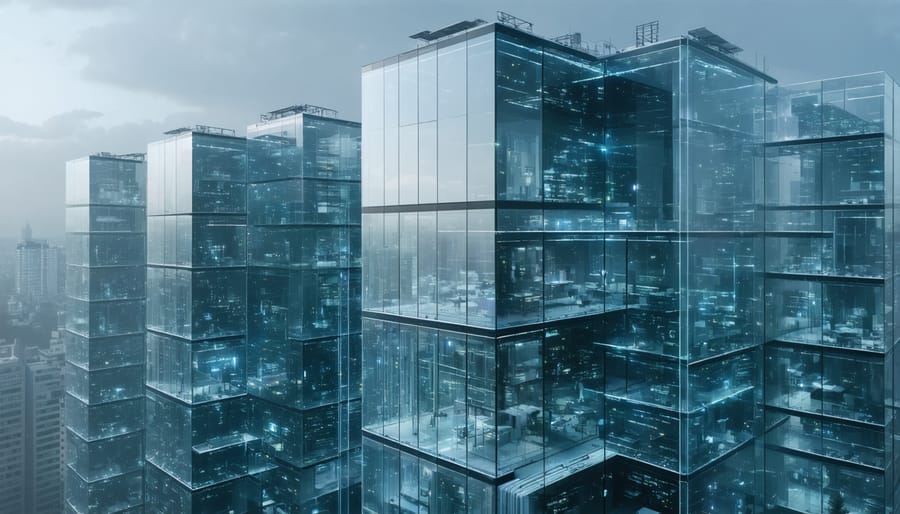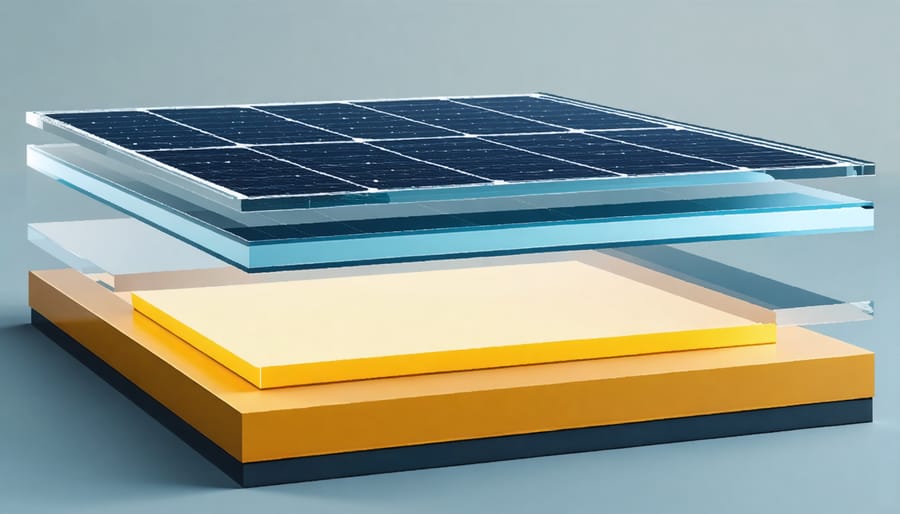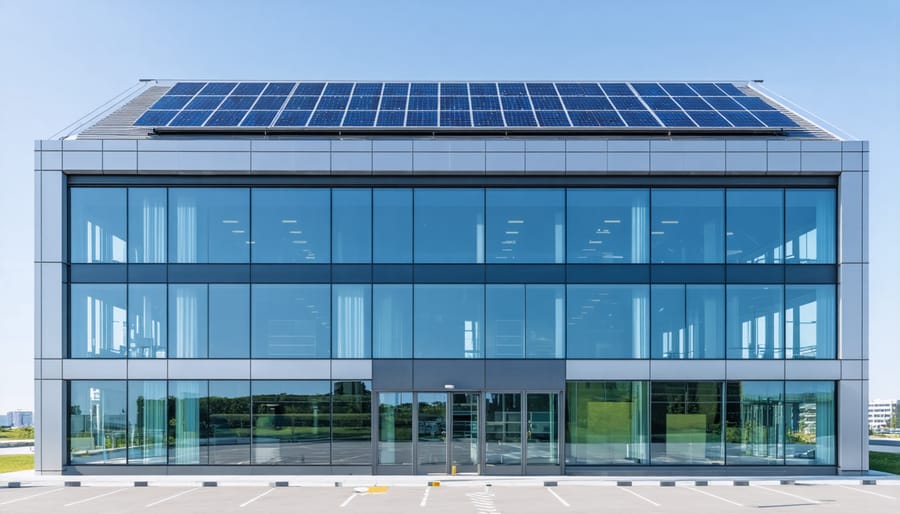Solar Windows Transform Buildings into Power Plants: The Next Evolution in Bioenergy Integration

Imagine transforming every window in your building into a clean energy generator while maintaining perfect transparency. Ubiquitous Energy’s revolutionary solar windows represent a groundbreaking shift in sustainable architecture, seamlessly integrating solar power generation into the very fabric of our buildings without compromising aesthetics or functionality.
Unlike traditional solar panels that occupy dedicated space, these innovative windows harness invisible parts of the solar spectrum while allowing natural light to pass through. This dual-functionality breakthrough enables European buildings to generate renewable energy from surfaces that were previously unutilized, marking a significant advancement in sustainable construction technology.
The impact extends beyond mere energy generation. As Europe accelerates its transition towards carbon neutrality, these solar windows offer building owners a practical solution to meet increasingly stringent energy efficiency regulations while contributing to smart city initiatives. With the potential to reduce building energy consumption by up to 50%, this technology represents a crucial step forward in achieving the EU’s ambitious climate goals.
For architects, developers, and property owners seeking to embrace sustainable innovation without sacrificing design freedom, Ubiquitous Energy’s solar windows open new possibilities in carbon-neutral architecture while maintaining the sleek, modern aesthetics demanded by contemporary European markets.
How Solar Windows Revolutionize Building Energy Systems
The Science Behind Transparent Solar Technology
The innovative science behind transparent solar windows relies on advanced photovoltaic technology that selectively harvests invisible light while allowing visible light to pass through. This is achieved through a specialized organic semiconductor coating that captures ultraviolet and near-infrared light waves, converting them into electricity while maintaining transparency.
The key component is a series of transparent luminescent solar concentrators (TLSC), which contain specially engineered organic molecules that absorb non-visible wavelengths of light. These molecules redirect the captured energy to conventional solar cells positioned along the edges of the window frame, where it’s converted into usable electricity.
What makes this technology particularly remarkable is its dual-function design. The organic semiconductors are tuned to absorb light outside the visible spectrum, specifically targeting wavelengths above 750nm and below 400nm. This selective absorption ensures the windows remain clear while simultaneously generating power. The technology typically achieves transparency levels between 50% and 70%, depending on specific applications.
The conversion process involves multiple layers of thin-film coating, each optimized for specific light wavelengths. These layers work together to maximize energy capture while minimizing impact on visibility. Recent innovations have improved the power conversion efficiency while maintaining aesthetic appeal, making these windows increasingly viable for commercial and residential applications across Europe.

Energy Generation Capabilities and Efficiency Rates
Ubiquitous Energy’s solar windows demonstrate remarkable efficiency rates, converting 10% of solar energy into electricity while maintaining up to 80% transparency. While traditional solar panels typically achieve 15-20% efficiency, these transparent solar windows offer a unique advantage by utilizing previously unused window surfaces for power generation.
On average, a standard-sized solar window (1m²) can generate between 8-10 watts of power under optimal conditions. For perspective, a typical office building featuring 2,000m² of solar windows could potentially generate up to 20 kilowatts of power during peak sunlight hours, sufficient to offset approximately 10-15% of the building’s energy consumption.
The energy generation capabilities vary based on several factors, including geographic location, window orientation, and local climate conditions. In Southern European regions, these windows can produce up to 50% more energy compared to installations in Northern Europe due to increased solar exposure. Urban installations have demonstrated annual energy yields of 40-50 kWh/m², making them particularly effective for commercial buildings with large window surfaces.
What sets these solar windows apart is their dual functionality: they not only generate clean energy but also reduce cooling costs by filtering out infrared light. This combination of benefits results in an overall energy efficiency improvement of up to 30% in modern buildings, making them a compelling solution for sustainable architecture and energy management.
Seamless Integration with Bioenergy Systems
Creating Hybrid Energy Solutions
The integration of solar windows with other renewable energy sources creates powerful hybrid energy solutions that maximize sustainability and efficiency. When combined with bioenergy systems, solar windows can form part of a comprehensive energy strategy that addresses both electricity generation and thermal management needs.
These innovative combinations leverage the strengths of each technology. While solar windows capture energy during daylight hours, bioenergy systems can provide consistent power regardless of weather conditions or time of day. This complementary relationship ensures more stable energy provision throughout the year, particularly beneficial for European climates with varying seasonal sunlight.
The synergy extends beyond power generation. Waste heat from bioenergy processes can be utilized for building climate control, while solar windows help regulate indoor temperature by filtering infrared radiation. This dual functionality reduces overall energy consumption and improves building efficiency.
For commercial buildings, this integration offers particular advantages. Office complexes can utilize solar windows for daytime power generation while incorporating biomass heating systems for winter months. Industries with high energy demands can benefit from the reliability of bioenergy while supplementing their power needs with solar window technology.
The implementation of these combined systems requires careful planning and expertise. Modern building management systems can optimize the interaction between solar windows and bioenergy components, ensuring maximum efficiency and return on investment. As European energy policies continue to promote renewable integration, these hybrid solutions represent a forward-thinking approach to sustainable building design.
Smart Energy Management Systems
The integration of smart energy management systems forms the technological backbone of ubiquitous energy solar windows, ensuring optimal energy distribution and utilisation throughout connected buildings. These sophisticated control systems continuously monitor and adjust energy flows between solar windows and bioenergy components, maximising efficiency while maintaining occupant comfort.
At the heart of these systems lies advanced AI-driven software that processes real-time data from multiple sensors. These sensors track factors such as solar intensity, indoor temperature, energy demand, and storage capacity. The system then makes intelligent decisions about energy routing – determining whether to direct solar-generated power to immediate use, storage systems, or the grid.
The management system coordinates seamlessly with building automation protocols, adjusting window transparency levels to optimise natural lighting and thermal comfort while maximising energy harvesting. During peak sunlight hours, the system can automatically prioritise energy collection, while in low-light conditions, it focuses on efficient energy distribution from stored reserves.
For European businesses and homeowners, these control systems offer unprecedented visibility into energy generation and consumption patterns through user-friendly interfaces. Building managers can access detailed analytics and performance metrics, enabling data-driven decisions about energy usage and system optimisation.
The integration capability extends beyond individual buildings to smart grid networks, allowing for community-level energy management and trading. This interconnectivity supports the European Union’s renewable energy goals while providing building owners with potential revenue streams through energy market participation.

European Implementation Success Stories
Commercial Building Applications
Solar windows have already made significant inroads in commercial architecture across Europe, demonstrating their versatility and effectiveness in modern building design. The EDGE Olympic building in Amsterdam serves as a prime example, incorporating transparent solar glazing across its façade while maintaining the structure’s aesthetic appeal and natural lighting requirements.
In Munich, the Quattro Business Centre showcases how solar windows can be integrated into both new construction and retrofitting projects. The building’s south-facing windows generate approximately 30% of its daily electricity needs while reducing cooling costs through enhanced thermal management.
Major shopping centres have also embraced this technology, with the Grand Plaza Mall in Brussels featuring solar windows across its atrium and main entrances. This installation not only produces clean energy but also creates an engaging talking point for visitors, highlighting the centre’s commitment to sustainability.
The technology has proven particularly effective in office complexes with large window surfaces. The Stockholm Business Park’s recent renovation incorporated solar windows throughout its 12-story structure, demonstrating how modern commercial buildings can transform traditionally passive surfaces into active energy generators.
These implementations showcase how solar windows can seamlessly blend into existing architectural designs while providing tangible benefits in terms of energy generation and building efficiency. The growing number of successful commercial installations continues to drive innovation and adoption across the European market.

Residential Project Highlights
Several pioneering residential developments across Europe have successfully integrated solar window technology, demonstrating its practical potential for modern homes. In Amsterdam, the Solar Heights apartment complex features 120 solar windows across its south-facing façade, generating approximately 8,500 kWh annually while maintaining the building’s sleek, contemporary aesthetic.
A notable installation in Munich showcases a private villa where 45 solar windows were retrofitted into existing frames, powering household electronics and contributing to the home’s smart energy management system. The project achieved a 30% reduction in grid dependency while preserving the property’s architectural character.
In Stockholm, the Eco Living residential community incorporates solar windows throughout its 25-unit development. The installation powers common area lighting and electric vehicle charging stations, demonstrating how the technology can support shared community infrastructure.
These implementations highlight the versatility of solar windows in different residential contexts. Homeowners report particular satisfaction with the windows’ dual functionality – providing natural lighting while generating clean energy – and their seamless integration with home automation systems. The technology’s ability to maintain consistent indoor temperatures has also contributed to reduced heating and cooling costs across these projects.
Monitoring data from these installations indicates optimal performance in both direct and indirect sunlight, making the technology suitable for various European climate conditions.
Future Prospects and Installation Considerations
Technology Advancement Pipeline
The solar window technology landscape is rapidly evolving, with several promising innovations on the horizon. Researchers are developing next-generation transparent photovoltaic materials that could boost efficiency rates to over 15% while maintaining excellent visibility. These advancements align seamlessly with modern energy technology integration, making solar windows increasingly viable for widespread adoption.
Current development focuses on enhancing the quantum dot technology used in these windows, potentially doubling their energy-harvesting capabilities. Manufacturers are also working on improving the durability of the transparent solar cells, aiming to extend their lifespan to match traditional windows’ 25-30 year warranty periods.
Another significant breakthrough involves the integration of smart-tinting capabilities, allowing windows to automatically adjust their transparency based on sunlight intensity. This dual functionality not only optimises energy generation but also provides improved thermal management for buildings.
The industry is also exploring cost-reduction strategies through automated manufacturing processes and sustainable material alternatives, potentially making solar windows more accessible to the European market within the next three to five years.
Installation and Maintenance Guidelines
Installing ubiquitous energy solar windows requires professional expertise and careful planning. The process typically begins with a comprehensive site assessment to evaluate building orientation, shading patterns, and existing window infrastructure. Qualified installers will ensure proper integration with your building’s electrical system and verify compatibility with local building codes.
Maintenance requirements are relatively minimal compared to traditional solar panels. Regular cleaning with non-abrasive, pH-neutral solutions helps maintain optimal transparency and energy generation. Quarterly inspections are recommended to check for any degradation in seals or electrical connections. Property owners should avoid using harsh chemical cleaners or abrasive materials that could damage the solar coating.
For maximum efficiency, consider implementing an automated monitoring system to track performance metrics and detect potential issues early. Professional maintenance services typically include annual thorough inspections of wiring connections, frame integrity, and coating condition. Most manufacturers offer comprehensive warranties ranging from 15 to 20 years, covering both the window units and power generation capabilities.
European property owners can access certified installation partners through manufacturer networks, ensuring compliance with EU energy standards and local regulations.
As we look towards a more sustainable future, ubiquitous energy solar windows represent a pivotal advancement in building-integrated photovoltaics. Their seamless integration into existing architecture offers European businesses and homeowners an innovative pathway to energy independence while maintaining aesthetic appeal. The technology’s ability to transform ordinary windows into power-generating surfaces marks a significant step forward in sustainable building design.
The potential impact of solar windows extends beyond individual buildings to reshape entire urban landscapes. By converting Europe’s vast window surface area into clean energy generators, we can significantly reduce our carbon footprint while creating more resilient and energy-efficient cities. This technology aligns perfectly with the EU’s ambitious climate goals and the growing demand for sustainable building solutions.
Looking ahead, the integration of solar windows with broader bioenergy systems presents exciting possibilities. As storage technologies improve and smart grid systems evolve, these transparent solar solutions will play an increasingly vital role in our energy infrastructure. For property owners, this means enhanced energy security, reduced operational costs, and improved building value.
The future of sustainable architecture lies in such innovative solutions that combine functionality with environmental responsibility. As the technology continues to mature and become more accessible, solar windows will undoubtedly become a standard feature in modern construction, contributing significantly to Europe’s clean energy transition and sustainable development goals.
Leave a Reply